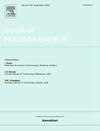Numerical study of flow evolution and secondary flow dynamics in helical coils with periodically varying curvature
IF 2.3
3区 工程技术
Q1 NUCLEAR SCIENCE & TECHNOLOGY
引用次数: 0
Abstract
Helical coil steam generators (HCSGs) are recognized as advanced high-efficiency heat exchangers for the nuclear industry. To further enhance heat and mass transfer both inside the coil tube and within coil bundles, the present study introduces an innovative concept: a variable-curvature helical coil tube combined with a longitudinal cross-arrangement helical coil bundle. This paper numerically investigates the evolution characteristics of the flow structure within the proposed variable-curvature helical coil. Using Reynolds-averaged Navier-Stokes (RANS) turbulence models, we analyzed the evolution of velocity fields, vorticity, Q-criterion, and turbulent kinetic energy (TKE). The simulation results reveal a transient flow structure where the secondary flow, vortex morphology, and TKE distribution dynamically adapt to the periodically varying curvature. Specifically, the size and distribution of secondary flow vortices are found to be strongly dependent on the axial position, directly correlating with the local curvature. Furthermore, the mixing efficiency is significantly enhanced in the regions away from the coil center compared to the central region, highlighting the crucial role of secondary flow in promoting transverse mass transfer. These findings provide valuable theoretical insights for the design and optimization of high-performance helical coil steam generators and heat exchangers.
周期变曲率螺旋盘管内流动演化及二次流动力学的数值研究
螺旋盘管蒸汽发生器(hcsg)被认为是核工业中先进的高效热交换器。为了进一步加强盘管内部和盘束内部的传热传质,本研究引入了一种创新的概念:变曲率螺旋盘管与纵向交叉排列的螺旋盘束相结合。本文对所提出的变曲率螺旋线圈内流动结构的演化特征进行了数值研究。利用reynolds -average Navier-Stokes (RANS)湍流模型,分析了速度场、涡度、q准则和湍流动能(TKE)的演化。模拟结果表明,二次流、涡形态和TKE分布动态适应周期性曲率变化的瞬态流动结构。具体来说,二次流涡的大小和分布与轴向位置密切相关,与局部曲率直接相关。此外,与中心区域相比,远离线圈中心区域的混合效率显著提高,突出了二次流在促进横向传质中的关键作用。这些发现为高性能螺旋盘管蒸汽发生器和热交换器的设计和优化提供了有价值的理论见解。
本文章由计算机程序翻译,如有差异,请以英文原文为准。
求助全文
约1分钟内获得全文
求助全文
来源期刊

Annals of Nuclear Energy
工程技术-核科学技术
CiteScore
4.30
自引率
21.10%
发文量
632
审稿时长
7.3 months
期刊介绍:
Annals of Nuclear Energy provides an international medium for the communication of original research, ideas and developments in all areas of the field of nuclear energy science and technology. Its scope embraces nuclear fuel reserves, fuel cycles and cost, materials, processing, system and component technology (fission only), design and optimization, direct conversion of nuclear energy sources, environmental control, reactor physics, heat transfer and fluid dynamics, structural analysis, fuel management, future developments, nuclear fuel and safety, nuclear aerosol, neutron physics, computer technology (both software and hardware), risk assessment, radioactive waste disposal and reactor thermal hydraulics. Papers submitted to Annals need to demonstrate a clear link to nuclear power generation/nuclear engineering. Papers which deal with pure nuclear physics, pure health physics, imaging, or attenuation and shielding properties of concretes and various geological materials are not within the scope of the journal. Also, papers that deal with policy or economics are not within the scope of the journal.
 求助内容:
求助内容: 应助结果提醒方式:
应助结果提醒方式:


